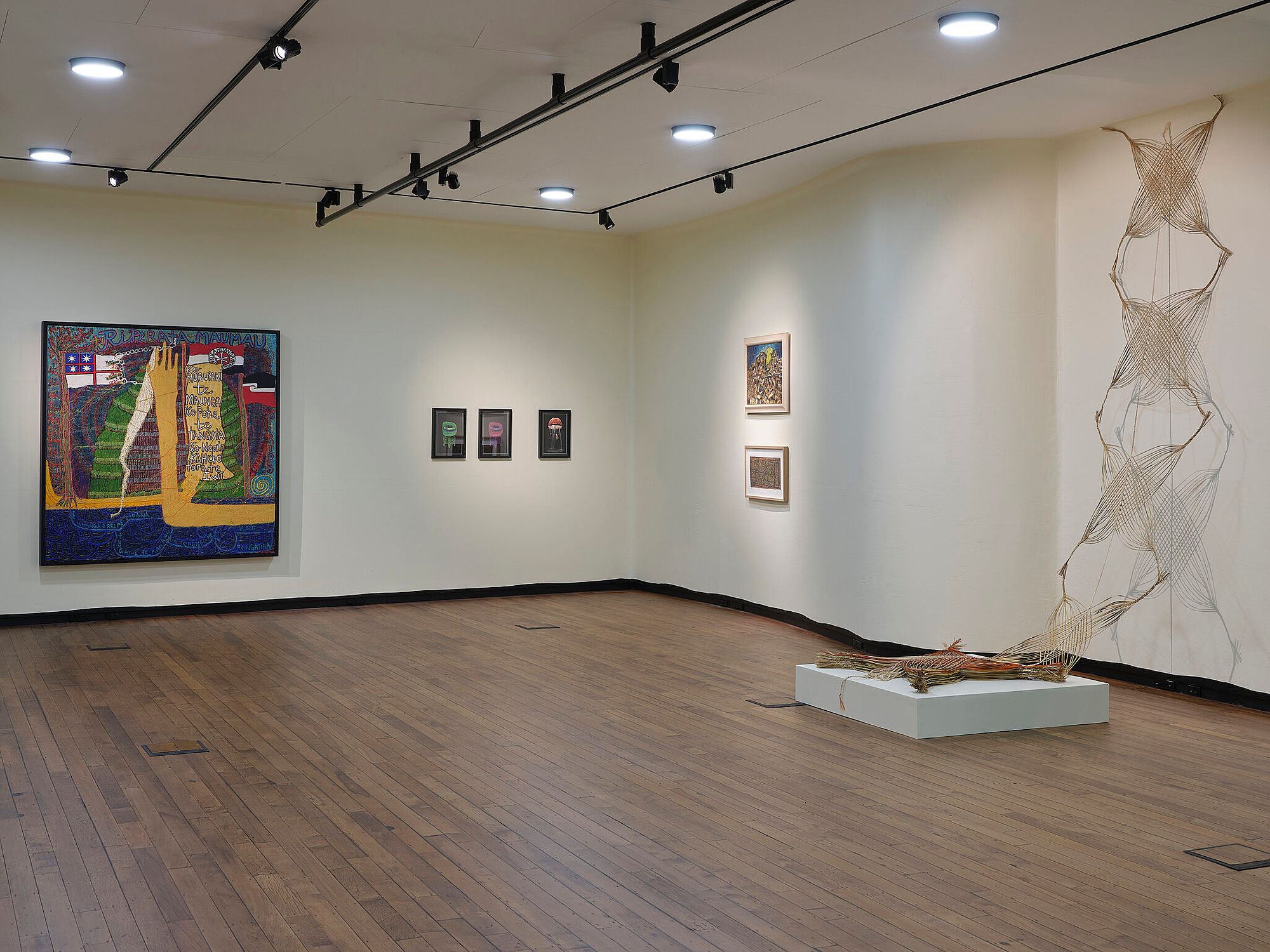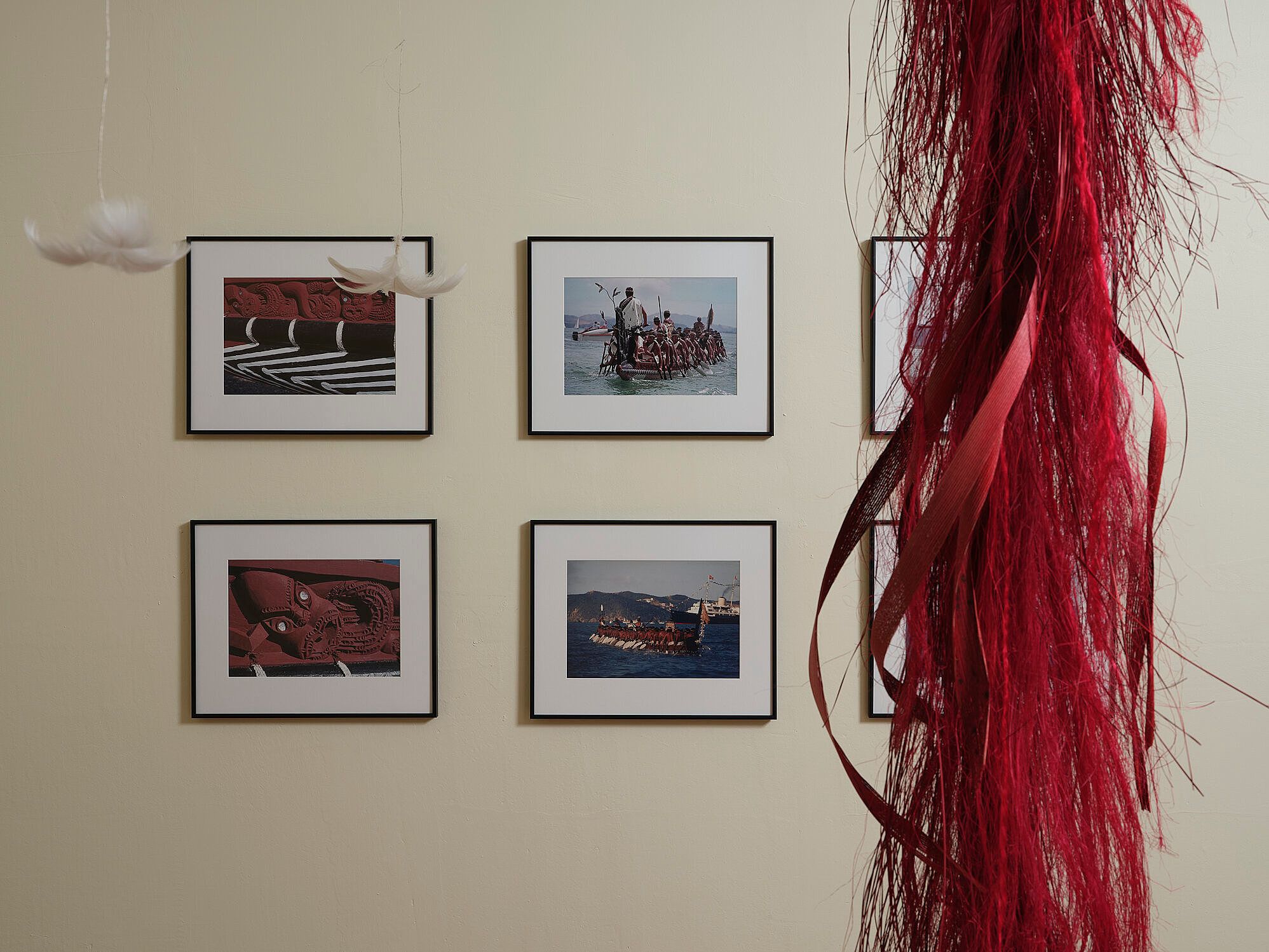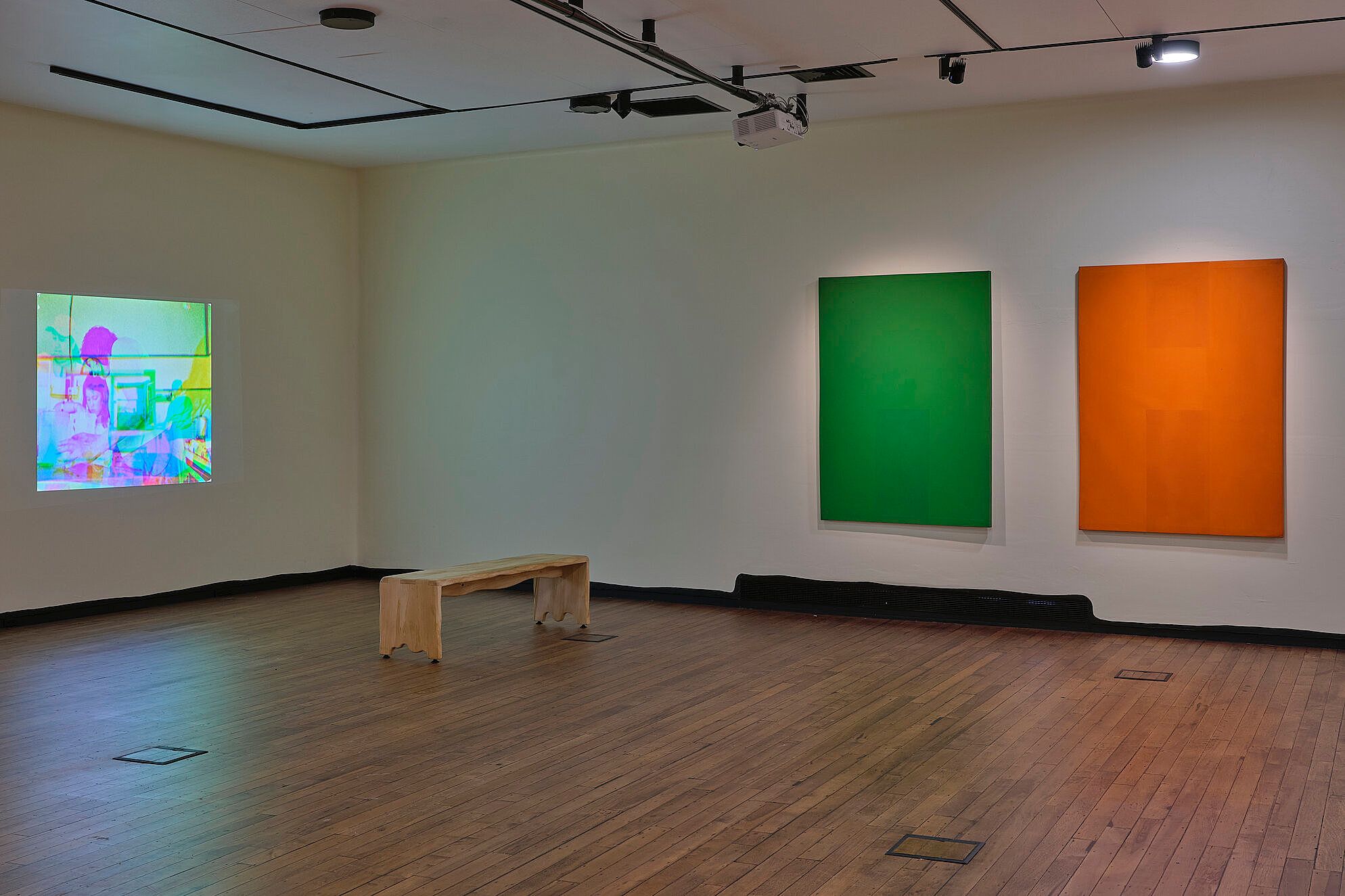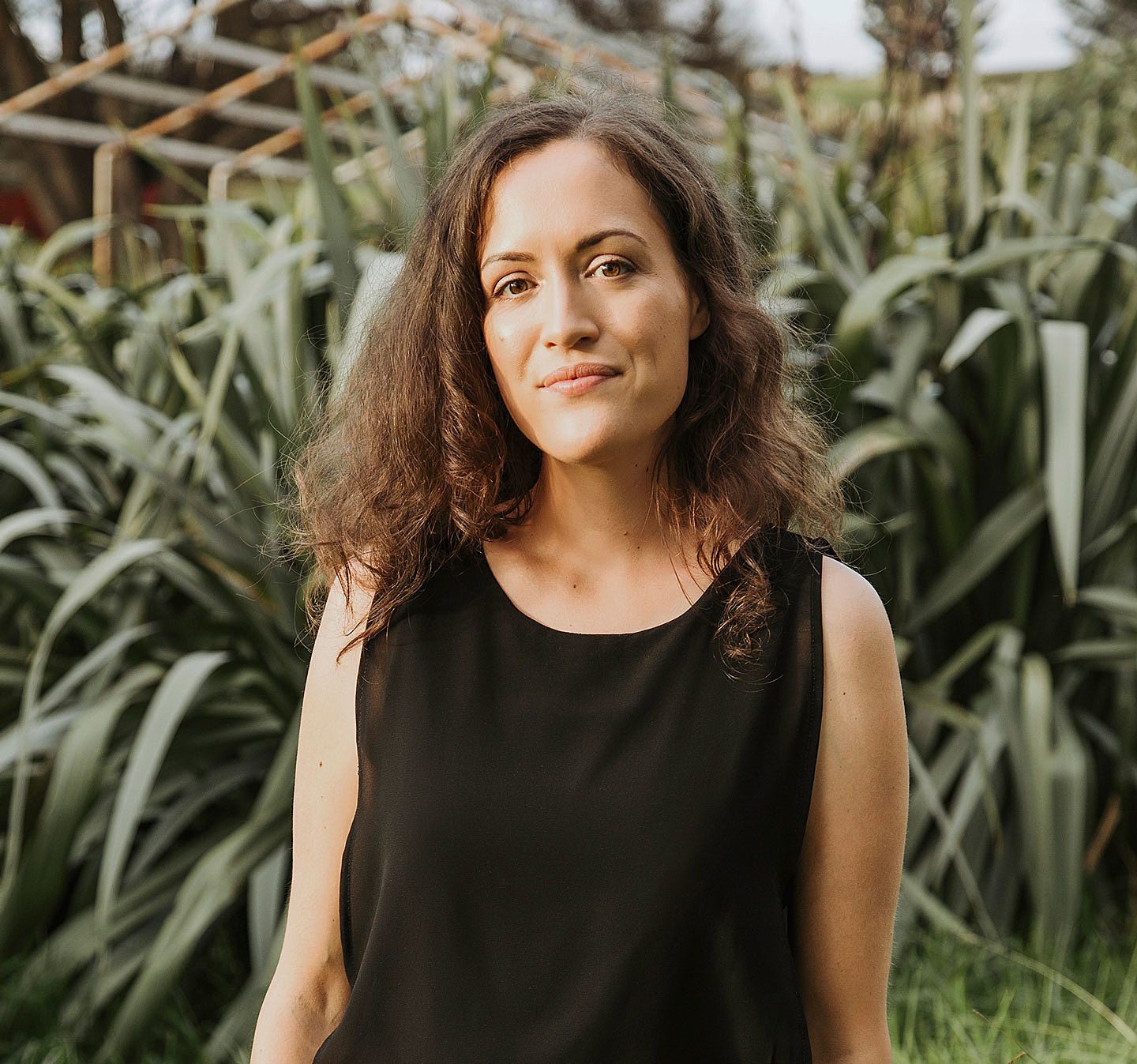We Are Still Here
Puhi Ariki, the inaugural show at Wairau Māori Art Gallery, recognises the whenua on which it stands and asserts the strength of Ngāpuhi-nui-tonu. Jade Kake reviews.
We arrive in darkness.
The surface of the Hātea (or Hōteo, depending on who you ask) ripples gently. A field of white sailboats sways atop the water. Our maunga, Parihaka, rises up above the awa in the distance. I circle the perimeter of the new building, the Hundertwasser Art Centre, taking a small private moment to absorb the boldness of the architecture, the latest addition to the Whangārei waterfront, to what has long been a colonial and colonised space.
He rangimārie. Everything feels still, and peaceful.
The streetlights disrupt the tapu of te pō, the scene awash with yellow light against a blackened sky, and not for the first time I wonder about the tikanga of this. The balance between public safety – maintained, primarily, through the application of Crime Prevention Through Environmental Design (CPTED) principles and AS/NZ Standards 1158 Lighting for Roads and Public Spaces – and the continuation of our tikanga, our mahi tapu, and the reasons these things occur under the cover of darkness.
“Is that you, then? Are you here to do the karanga?” my whanaunga jokes, gesturing towards the kuia
The sky is still inky as people begin to arrive in dribs and drabs. It’s a darkness that precedes the breaking of the dawn by some hours. I see my Te Parawhau relations and shuffle over.
“Is that you, then? Are you here to do the karanga?” my whanaunga jokes, gesturing towards the kuia who are our kaikaranga i tēnei ata.
“Maybe when I get asked in 20 years,” I respond with a smile. “For now, I’m here to listen and learn,” I say as I join our manuhiri.
In the enactment of tikanga, we will transition between te pō and te ao, the kaikarakia and kaikaranga guiding us through the phases of karakia as the sky gradually lightens – te pō and atapō (before dawn).
The tikanga of the morning unfolds. A tree is planted. There is a karanga and a wero. A name is gifted to the carved pou recently installed outside the gallery space, and another to the cleansing stone at the entrance.
Puhi Ariki opening. Image: Sam Hartnett
We spill into the gallery, circling the perimeter walls as a low continuous chant reverberates through the space. Eventually, the circling stops, and we settle into a mihi whakatau. My eyes dart around the walls, taking in the exhibit for the first time. Ka mutu te kōrero. Waiata rises up, filling the room.
As we leave, to repeat a variation on the process in the permanent gallery upstairs, we bless ourselves with wai māori from the cleansing stone near the entrance to the gallery. When we exit the building, the orange is being drained from the sky, moving through ata hapāra (dawn), te ata tū (daybreak) and, finally, awatea, the time when the morning is firmly established, the responsibilities of our tikanga fulfilled and completed.
The whare hou – the Hundertwasser Art Centre located on the Whangārei waterfront – has been more than 30 years in the making, and has not been without controversy. Conceptualised by Austrian artist and architect Friedensreich Hundertwasser, who developed and maintained strong ties to Te Tai Tokerau within his lifetime – his work in the north is closely associated with the village of Kawakawa – the building is an expression of Hundertwasser’s thoughts and philosophies of architecture, and part of a larger oeuvre of work. Its development has been championed by the district council and passionate members of the local community.
Whangārei hapū were famously excluded from the development of the waterfront by the council in the 1990s, giving rise to the vision for the Hīhīaua Cultural Centre
The building is both a challenge to the rigid neo-coloniality of the Whangārei waterfront (Whangārei hapū were famously excluded from the development of the waterfront by the council in the 1990s, giving rise to the vision for the Hīhīaua Cultural Centre) and, contestably, an extension of it. There’s an argument to be made that the architectural identity of our rohe should not be defined by and so closely associated with a European architect, albeit one with strong local ties (including with Māori communities in the North).
Perhaps the most interesting thing about the building is the ways in which it both honours Hundertwasser’s original intent, and is also grounded and contextualised within Whangārei, within Te Tai Tokerau. This is evident in the carved pou – given the name Te Pou Tāhuhu a Kūkupa in reference to one of our significant Te Parawhau tūpuna and carved by Chris Bailey (Te Aupōuri, Ngāti Pāoa, Ngāti Porou, Ngāti Hako) – which greets visitors at the waterfront entrance, and the extensive use of native plants within the landscape, including the impressive and expansive rooftop garden.
A steel-string rendition of ‘Ngā Puawai o Ngāpuhi’, the unofficial Ngāpuhi anthem, fills the space
The Wairau Māori Art Gallery – which, I’ve heard, was a somewhat late addition to the project but has long since been firmly embedded as an integral part of the project and subsequent building – is in many ways the highlight of the building and of the visitor experience. It is an anchor to Te Tai Tokerau and a celebration of the many esteemed tohunga mahi toi who whakapapa to the tribes of Te Tai Tokerau.
The Wairau Māori Art Gallery is nestled within the ground level of the building. The gallery space presents a unique curatorial challenge. In honouring the intent of Hundertwasser, the walls are painted cream, and, like much of the building, curve and meander. A thick black outline runs around the doors and windows and along the top and bottom of the walls. The floors are timber, reminiscent of the deck of a ship. Not your usual blank canvas.
The inaugural show, Puhi Ariki, has been curated by Nigel Borell (Pirirākau, Ngāiterangi, Ngāti Ranginui, Te Whakatōhea). As I sit and kōrero with Nigel in the light of day, te poupoutanga o te rā, the gallery is bustling with excited visitors. A steel-string rendition of ‘Ngā Puawai o Ngāpuhi’, the unofficial Ngāpuhi anthem, fills the space, the waiata a rousing accompaniment to Nova Paul’s (Ngāpuhi, Te Uriroroi, Te Parawhau, Te Māhurehure ki Whatitiri) experimental film work, This is not Dying (2010).
Puhi Ariki installation view, 2022, Wairau Māori Art Gallery. Image: Sam Hartnett
The heft and significance of the inaugural show is not lost on Borell. This is the first exhibition of many, in a dedicated Māori art gallery within a significant new public building in Whangārei. The exhibition recognises where the gallery stands and unashamedly privileges Ngāpuhi-nui-tonu in the selection of artists. A vast range of artistic mediums and a diverse range of artists across generations are represented in the show, including iconic pioneers such as Ralph Hotere (Te Aupōuri, Te Rarawa) and Maureen Lander (Ngāpuhi, Te Hikutu, Te Roroa), and younger artists such as Israel Tangaroa Birch (Ngāpuhi, Ngāi Tawake, Ngāti Kahungunu, Ngāti Rakaipaaka) and Leilani Kake (Ngāpuhi, Tainui-Waikato, Rakahanga-Manihiki – Cook Islands).
The show serves to dismantle the white box, challenging the conventions of the art world and the ways in which we inhabit spaces. The space not only grounds and contextualises the building: the space opened up by the Wairau Gallery provides a unique opportunity – for curators, artists and mana whenua hapū – to create new relationships to ideas that are uniquely shaped by us within this dedicated Māori arts space.
"One of the things about curating,” Borell tells me, “is that it's about dismantling the things that don't work for us and being true to the things that do."
The exhibition unashamedly privileges Ngāpuhi-nui-tonu in the selection of artists
The show’s title, Puhi Ariki, references the plumage that trails the taurapa of the waka and is a direct reference to Ngāpuhi and a metaphor for working together in unison. In applying the metaphor, the artists are the puhi ariki that adorns the space. When everyone is rowing together in unison and the waka gains momentum, the puhi ariki glides above the water.
The works chosen for the show feel intensely personal and immediate. The whakapapa connections – between artists; between the artists and the whenua; and my own connections back to the artists and the whenua – are twisted and bound together through our shared whakapapa and shared experiences, like the braided muka of Te Hemo Ata Henare’s (Ngāti Kahu, Ngāti Hine, Te Whakatōhea) Ka Nukunuku! Ka Nekeneke (2022) or the woven harakeke and muka of Maureen Lander’s Ko Puhi Moana Ariki te Tupuna (2010).
The show’s title, Puhi Ariki, references the plumage that trails the taurapa of the waka and is a direct reference to Ngāpuhi and a metaphor for working together
Some of the artworks reference the puhi ariki directly, such as Henare’s Ka Nukunuku! Ka Nekeneke (2022), with the white huruhuru of the toroa (albatross) representing the karu of the waka, and the muka whiri (plaited muka, dyed red) representing the puhi ariki.
The story goes like this – when our tūpuna first arrived in Aotearoa, they wore red feathers (raukura) in their hair as a symbol of status, of rangatiratanga. From a distance, they could see red feathers in the trees, and concluded that there were already plenty of red feathers on these new islands, discarding the raukura they wore. As they drew closer, they discovered the red was not, in fact, the feathers of manu, but the red blooms of the pōhutukawa.
This pūrākau – recently shared in my te reo class by our kaiako – begins in a small way to reveal the whakapapa of kura (red) as a status symbol, retaining the metaphorical and symbolic qualities but transposed into other materials. Although we no longer wear red feathers, the symbology remains in our language. It’s these metaphors and symbolism that are key to storytelling.
“Then Prime Minister Norman Kirk was in the middle of the waka, and the Queen was on the ship,” he tells me matter-of-factly.
John Miller, The Launch of Ngātokimatawhaorua, 1974, in Puhi Ariki, Wairau Māori Art Gallery, 2022
John Miller’s (Ngāpuhi, Ngaitewake-ki-Uta) series of photographs The Launch of Ngātokimatawhaorua (1974) documents a significant moment in history: the relaunching of Ngātokimatawhaorua – named for our ancestral waka and its living embodiment – after more than 30 years of inactivity, the literal puhi ariki visible in the photographs.
As I sit with Miller earlier in the week, before visiting the exhibition, he shows me copies of the images selected for the show.
“Then Prime Minister Norman Kirk was in the middle of the waka, and the Queen was on the ship,” he tells me matter-of-factly.
Miller’s stories are all like this – astonishing in the historical significance of the events he has borne witness to and documented, and always delivered in a direct, understated manner, with a stunning recollection of details, the specifics of who and where. My whakapapa feels intimate and precious as the conversation moves on, and he recounts stories of my uncles at Pehiāweri Marae, who have long passed, and whom he knew well.
Puhi Ariki installation view, 2022, Wairau Māori Art Gallery. Image: Sam Hartnett
Other works are more abstract. The pared-back works of Ralph Hotere – Green Painting and Orange Painting (from the Zero Series) (1966–67) – are best summed up in the words of his friend and poet laureate Hone Tūwhare in the poem ‘Hotere’ (in his book Come rain hail, 1969). Tūwhare describes “a visual kind of starvation”, opening up new possibilities, creating space, conjuring up the Sāmoan concept of ‘vā’, the space in between, and ‘te kore’, the fertile nothingness.
Leilani Kake’s work Wai Rua (2022) references our shared whakapapa (yes, Leilani is my cousin) back to Pehiāweri Marae and Ōtuihau, the degradation of our waterways and the loss of land, with our whenua once extending to the falls, eaten away and now confined to a much smaller footprint. Her Swallow Green and Swallow Red (from the Swallow series) (2017) hit me on a visceral level in relation to my personal experience, the irony and indignity of being forced to swear allegiance to the Queen on whenua stolen (or otherwise illegitimately alienated) from my tūpuna, to obtain my New Zealand citizenship as an Australian-born Māori.
Nova Paul’s This is not Dying (2010) is a film work (transferred to video) that runs for close to 20 minutes. The work invites you to slow down and linger a while, and the images of rural Māori life are warm, familiar. The bright hues of the three-colour-separation technique Paul has used create a ghostly, nostalgic effect. You could almost believe this is the distant past and not the continued day-to-day reality for our whānau, our whanaunga. The illusion is broken as I spy one of our Te Parawhau kuia in the wharekai of Maungārongo Marae. They’ve recently put in a tono for funding to upgrade and revitalise the marae complex, which I’ve been helping to support. As I think of Maungārongo, my mind is awash with the complexities of tikanga and the (in)ability to perform it in (in)appropriately configured spaces.
The show achieves what it sets out to do – to whakamana our people, as uri of Ngāpuhi-nui-tonu, to recognise the whenua on which this building stands, within the rohe of Te Parawhau, to set the tone for all that is to come in this new space, and to reassert unequivocally that we are not dying, we are still here.
Emily Karaka’s (Waikato, Ngāpuhi, Ngāi Tai ki Tāmaki, Te Kawerau ā Maki, Ngāti Tamaoho, Te Ākitai Waiohua, Te Ahi Waru, Ngāti Mahuta, Ngāti Tahinga, Ngāti Hine) PEPEHA (2021) is a large painting, oil and acrylic on canvas. The work is visually arresting, drawing the eye and filling the space. It is a complex tapestry of the history of raupatu, and our continuous efforts to uphold our hapū rangatiratanga and responsibilities of mana i te whenua. This, too, feels intensely personal, the whakapapa on canvas a shared one that connects and binds. It is perhaps no coincidence that the day of the karakia, my cousin and I attend a hui-a-hapū in Ngunguru to tautoko our Te Waiariki whanaunga in the purchase of their ūkaipō, their tūpuna whenua in Ngunguru. Ka whawhai tonu mātou.
As always, it is about whakapapa, and the inextricable connection between people and land. The show achieves what it sets out to do – to whakamana our people, as uri of Ngāpuhi-nui-tonu, to recognise the whenua on which this building stands, within the rohe of Te Parawhau, to set the tone for all that is to come in this new space, and to reassert unequivocally that we are not dying, we are still here.
Feature image: Sam Hartnett





